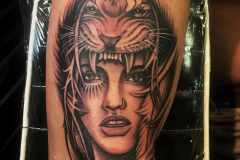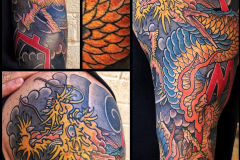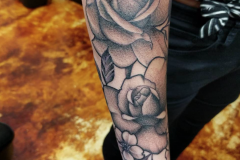After Care
Getting a tattoo can be a meaningful, memorable, and intimate experience. It can take months of careful contemplation and thought to create or choose a design. Why invest time, thought and money into a tattoo only to dampen the experience by making some mistakes?
There are many ways you can protect your body health-wise before getting inked, such as immunization shots and careful research. Yet, when it comes to the post-tattoo part, it’s common for good after-care practice to be forgotten. This leaves your tattoo’s health at risk.
After a tattoo, avoid:
Sunlight exposure
Water contact
Heavy sweating through intense exercise
Prolonged contact and rubbing
Applying harsh products to the area
Understanding the Process
Although the result can often be a simple one, tattooing is no straightforward process. It requires extreme skill, intricate technique and focus. Understanding how a tattoo works and the process involved helps us to understand why avoiding certain things afterward is essential.
High-Quality Tattoo Shops
The best tattoo parlors should make a tattoo experience look a little like this:
Cleanse: The tattoo artist will cleanse their hands with antibacterial soap and apply gloves and, often, a surgical mask
Wash: They’ll also wash the area of your body with antibacterial soap, to remove germs, and shave the area if necessary
Sterilized: The area of your body will then be sterilized, and petroleum jelly or ointment will be applied
Equipment: The equipment and devices used for the tattoo will also be cleaned and sterilized
With the above steps in play, your skin will heal much faster, and your entire tattoo process will be as enjoyable as it should be.
The Science
The skin is made up of three layers:
Epidermis — the outer layer
Dermis — just underneath the epidermis
Hypodermis — the sub-layers of the skin
The epidermis consists of five sub-layers in which the tattoo needle must pass through to reach the dermis tissue. When you think about it, that’s a lot of layers to penetrate, making it even more vital that you allow your body’s epidermis to heal afterward.
Upon the ink pigment being inserted through these layers, the immune system signals to combat the unknown substance. Some of the ink is removed by the immune system, causing no harm to the individual. The ink cells not destroyed by the body remain and embed into your skin permanently.
Five Things To Avoid Doing After Getting a Tattoo
Taking careful care of your new tattoo is vital. It will prolong the life of the tattoo and keep it looking fresh. If you avoid these below factors, you’re making huge strides in ensuring your tattoo is of the best quality.
Dodge Those Rays
Ultraviolet radiation, or UVA rays, deeply penetrates the skin’s layers, triggering wrinkles and premature aging. Continuous exposure to UVA rays will trigger the ink to wear down, making way for white blood cells to remove it. The result is your tattoo fading over time or the color being altered.
Cool It & Keep Dry
A tattoo artist will customarily tell you not to submerge a newly inked tattoo in water. It’s recommended to wait 24 hours before showering; however, this isn’t suggested by all tattoo outlets. What they will all advise, though, is to stay away from completely submerging the tattoo for at least 3-4 weeks until it’s fully healed. Stick to short, five-minute showers if possible.
When showering, the temperature of the water should be lukewarm at most, and the water jets shouldn’t be directed directly onto the tattoo. Be gentle with your new ink.
Stop That Sweat
Try to avoid strenuous exercise that could result in over-exertion. This will, in turn, lead to sweating. Heavy perspiration with a new tattoo is strongly unadvised since consistent and excessive moisture on the tattoo can halt healing, and promote bacteria growth.
Hands Off!
As with all surface wounds, a tattoo should be left alone. It is, in some sense, an open wound. Actions such as scratching, picking at the tattoo, or excessive rubbing will extend the healing process and possibly introduce infection to the area.
Try also to avoid wearing clothing with scratchy, abrasive materials. Be gentle with the fresh tattoo. Tight clothes should also not be worn; the tattoo must be allowed to breathe, and constant rubbing over the area could delay healing and cause further soreness.
Take Care!
Avoid harsh, strong scented products such as perfumes, as these will irritate fresh ink. It’s also best to stay away from products with no scientific backing in regards to their benefits for tattoos. Opt for a non-petroleum-based product, which will allow your skin to breathe and minimize irritation or excessive dryness.
The best tattoo lotion I’ve ever personally used is a (vegan) aftercare product called Hustle Butter. This stuff works amazingly well during the healing process – not only to keep your tattoo really well hydrated, but it’s also very good at soothing any annoying itchiness or irritation.
When applying the lotion, ensure you only put on a very small amount – just enough to give the surface a slight shine. Too much lotion will suffocate the area and could delay healing.
Also, ensure the area is totally dry before adding any lotion or moisturizer. You don’t want any water trapped between your skin and the lotion as this could lead to tattoo bubbling and potential ink loss.
Why You Should Care
Getting a tattoo poses more thought than mere aesthetics. The procedure involves penetration of the skin, temporarily damaging the skin layers. Thus, you should be as vigilant with aftercare as you would be upon a visit to the hospital.
A lack of good post-tattoo care can leave your body vulnerable to a host of germs, bacteria and infection. Be dedicated to your post-tattoo care to reduce the risk of complications, such as:
Skin infection: A skin infection is more likely to occur in the first two weeks. This results from bacteria entering the recovering wound. Symptoms include redness and discomfort. Psoriasis and dermatitis are two possible infections.
Skin inflammation: Such as keloids or granuloma
Allergic reaction: Delayed allergic reactions to the components within the ink are possible, particularly if the area isn’t well cared for.
Good Tattoo Aftercare
Now you know of the things to avoid, here are some quick tips on proper tattoo aftercare:
Hydrate: Drink plenty of water to keep your skin moisturized and hydrated
Clean: Regular cleansing with unscented soap is vital to rid the area of germs
Frequently Asked Questions
Will My Tattoo Change Color With Time?
Tattoos can fade over time, especially in areas of the feet and between the fingers. It’s essential to have a good cleaning regime and use UV protection.
Why Is My Tattoo Flaking Away?
This is perfectly normal. In fact, it’s your body working on its healing process. After flaking, the clean and clear tattoo will be left. Many tattoo shops offer free touch-ups if you’re unhappy with how much your tattoo has flaked away, as long as you’ve treated it as well as possible while healing.
Tattoos can peel a lot while being washed, but this is completely normal.
Can I Remove the Tattoo Wrapping Straight Away?
Even if the plastic wrapping bothers you, it’s important not to remove it too soon. The bandage is doing a great job of protecting the open wound and shielding the skin from bacteria or dust. Keep it on for at least the first night, unless your artist recommends you to remove it sooner. They know best.
Take Note
Getting a tattoo is a game-changer; we know that feeling all too well. Yet, we also hear of people not taking care of their new skin after the artwork is done. This can diminish the excitement of your new tattoo, so don’t fall into that trap!
Be sure to avoid direct sunlight as the UVA rays will cause damage and fading. Try to minimize complete submergence in water, and if showering, set the temperature to low. In essence, treat your tattooed area as if it’s an injury or wound, and you’ll be on the right track.
Article Last Updated on April 12th, 2020




